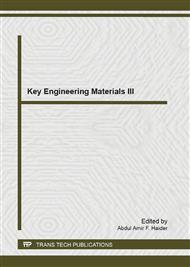p.333
p.337
p.342
p.349
p.354
p.359
p.364
p.370
p.375
Investigation of Chip-Tool Interface Temperature during Turning of Hardened AISI 4340 Alloy Steel Using Multi-Layer Coated Carbide Inserts
Abstract:
In the present work, effect of work material hardness and cutting parameters on chip-tool interface temperature was investigated during turning of AISI 4340 steel hardened at two different levels of hardness 35 and 45 HRC, respectively, using CVD applied multi-layer TiCN/Al2O3/TiN coated carbide inserts. A tool-work thermocouple principle was used to measure the interface temperature during turning. The correlation coefficient between experimental and predicted values of interface temperature found close to 0.95, which showed that the developed model is reliable and could be used effectively for predicting the interface temperature for the given tool and work material pair and within the domain of the cutting parameters. Experimental observations indicate that the interface temperature is higher for harder work material and get affected mostly by cutting speed followed by feed. However, depth of cut has little influence on interface temperature irrespective of the hardness of the workpiece.
Info:
Periodical:
Pages:
354-358
Citation:
Online since:
May 2013
Authors:
Price:
Сopyright:
© 2013 Trans Tech Publications Ltd. All Rights Reserved
Share:
Citation:


